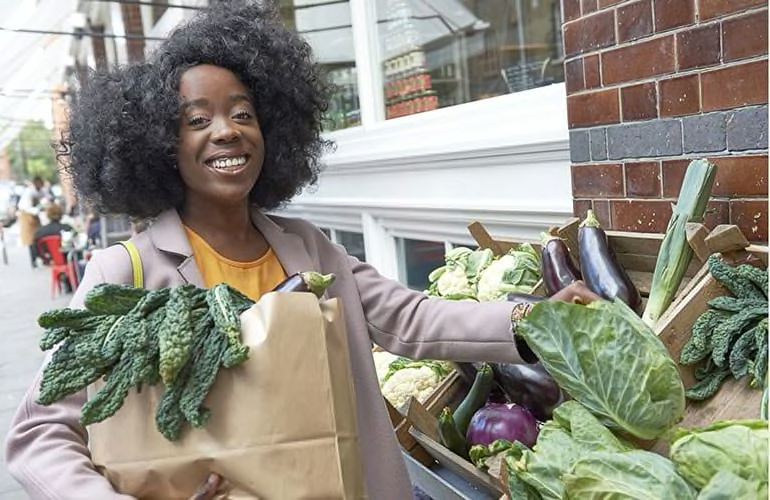Like a rock-solid friendship or the perfect little black dress, much of the advice experts give women on what to eat for their health—more produce, less sugar—works well at any age.
But as you journey through life, you will inevitably encounter health challenges that you can manage—at least in part—by making the right diet choices. Read on for tips on what to eat to stay well in your 20s and 30s, 40s and 50s, and 60s and beyond.

In your 20s and 30s
Bring back the dinner party. Women and men in this age group are more likely than other generations to see restaurants as a place to gather socially, according to research firm Technomic. And while there's nothing wrong with dining out, doing so frequently can be a challenge to your health—more than 90 percent of meals from sit-down restaurants (both chain and local) have more calories than the average person should eat in a day, according to a 2016 Tufts University study published in the Journal of the Academy of Nutrition and Dietetics.
To keep your social calendar booked but minimize the dietary damage, invite friends to your place, where you'll have control of the menu and can serve more nutritious but equally delicious foods—think beet hummus and crudités and watermelon and feta skewers for hors d'ouevres instead of fried calamari and spinach and artichoke dip. "Learning how to prepare simple, healthful meals now will get you into the habit for a lifetime," says Maxine Siegel, R.D., manager of food testing at Consumer Reports.
Focus on folate. Women of childbearing age—even if they aren't actively trying to get pregnant—should pay attention to getting enough of the B-vitamin folate. It's needed for a developing baby's proper cell growth and for preventing neural tube defects like spina bifida.
Foods like lentils and dark green vegetables are good sources of the nutrient. Supplements, however, can be a more reliable source, says Mary Jane Minkin, M.D., clinical professor of obstetrics, gynecology, and reproductive sciences at Yale School of Medicine. If you're actively trying to become pregnant or plan to start within a month, consider a supplement, and continue it throughout your pregnancy. Aim for 400 micrograms per day, which is the amount recommended by the Centers for Disease Control and Prevention.
Learn to prep healthy food, fast. Takeout is convenience-wise but often health-foolish. Fortunately, with a little planning you can whip up a meal in about the same amount of time it takes to have a pizza delivered. Designate an hour or so on a weekend toward prepping a variety of versatile ingredients like grilled chicken, chopped veggies, quinoa, beans, and grated cheese that you can combine in different ways throughout the week, says Amy Keating, R.D., one of Consumer Reports' registered dietitians.
Make smart seafood choices. The most recent guidelines from the Food and Drug Administration and the Environmental Protection Agency advise women of childbearing age to avoid high-mercury fish like swordfish, king mackerel, marlin, and bigeye tuna. A Consumer Reports analysis found that 20 percent of samples of canned light tuna tested contained high amounts of the toxin; as a result, CR experts recommend that pregnant women avoid it altogether and other women eat it only in moderation. Eating a 4-ounce serving of the lowest mercury fish, such as salmon, sardines, and shrimp, two to three times per week, however, will keep mercury exposure low while providing you with a healthy dose of omega-3s, fatty acids that are important for infant brain development and preventing heart disease.

In your 40s and 50s
Tap an expert. Many women find themselves putting on pounds as they approach and go through menopause. With age comes a decline in muscle mass. Because there's no one-size-fits-all formula for maintaining a healthy weight, meeting with a pro who can help you navigate your individual challenges and help you reach your personal goals is worth it. "Working with a dietitian to develop a sensible food plan will go a long way in helping to prevent excess weight gain," says Nancy DiMarco, Ph.D., R.D.N., director of the Institute for Women's Health at Texas Woman's University in Denton, Texas. Another method of combatting midlife weight gain: exercise, particularly strength training, which can help minimize muscle loss and keep your metabolism up.
Put soy on your plate. As women approach menopause, risk of heart disease increases as estrogen levels drop. Research suggests that soy foods, such as edamame, tofu, and tempeh, may help prevent heart disease by reducing LDL bad cholesterol levels; compounds in soy may also help improve bone mass and possibly lessen hot flashes during menopause. "Soy contains weak plant estrogens called isoflavones," says Minkin. If you're not sure about soy foods, ground flaxseed also contains plant estrogens—try sprinkling it in your morning oatmeal.
Bone up on calcium. When you reach age 50, calcium needs increase from 1,000 mg per day to 1,200. The reason? After menopause, the ovaries stop producing estrogen, which helps your gut absorb calcium, DiMarco says. As a result, your bones absorb less calcium from your bloodstream. Women are more likely than men to fracture bones due to osteoporosis; getting enough calcium in the diet from foods like yogurt, kale, milk, collard greens, sardines, and cheese is one dietary strategy that may help decrease your risk. Discuss with your doctor before popping calcium pills, though—a 2016 study published in the Journal of the American Heart Association suggests that calcium supplements may be linked with increased risk of cardiovascular events.
Separate from salt. The effects of sodium on blood pressure tend to be more pronounced in people ages 50 and older, according to the American Heart Association (African Americans and anyone with high blood pressure, diabetes, and kidney disease of any age also tend to be more sensitive). The AHA recommends keeping your sodium intake to no more than 2,300 mg per day, and preferably to 1,500 mg, to help blunt the rise in blood pressure that occurs with age, decreasing your risk for heart attack, stroke, and more. If the U.S. sodium intake went down to an average of 1,500 mg per day (people age 45 to 59 currently eat closer to 3,510 mg), it could result in a 25.6 percent overall decrease in blood pressure, according to the AHA. Rethink your dining out and grocery shopping habits before you banish the saltshaker; more 70 percent of the sodium we eat comes from restaurant and processed foods, according to a May 2017 study published in the journal Circulation.

In Your 60s and Beyond
Bring on the berries. They're the only fruit that benefit brain health, according to researchers who study the MIND diet (Mediterranean-Dash Intervention for Neurodegenerative Delay), a plan that focuses on foods that play a role in preventing age-related cognitive decline. Women ages 70 and older who ate blueberries once per week or strawberries twice per week or more had a brain age as much as 2½ years younger than those who ate the berries less than once per month, according to a Harvard study that followed more than 16,000 women over almost 20 years. The antioxidants in berries can help activate the brain's "housekeeper" mechanism, which helps clean out parts of cells that have become damaged.
Don't wait to hydrate. Our thirst mechanism weakens as we get older. Though everyone's needs are a little different, the Institute of Medicine estimates that women need around 9 cups of fluids per day—though not all of it needs to be plain water. Soup, coffee, and tea count, and fruit and vegetables also contribute to your fluid intake. You can determine whether you're drinking enough based on the color of your urine—light yellow or straw-hued is the goal. "Fill a pitcher in the morning with the amount needed per day," says Keating. Pour glasses of H20 throughout the day, with the goal of having it emptied by bedtime.
Bump up the protein. Despite what seems like a constant push for us to get more protein in our diets, most Americans don't have trouble taking in enough of this muscle-building, satiety-boosting nutrient. Age, however, makes us less efficient at using protein, and findings support the idea that older adults get slightly more than the current recommendation to prevent age-related muscle loss known as sarcopenia, which can increase the risk of disability. After age 60, aim for at least 0.6 gram per pound daily (younger adults need 0.4 gram per pound each day).
Get (even more) serious about food safety. Protecting yourself from foodborne disease is always important. But as we grow older, our bodies become less equipped to fight off pathogens and recover from potential illness. So it's crucial that older women—along with the very young and pregnant—are extra careful to minimize exposure to the pathogens that can cause foodborne illness.
5 Tips to Change the Way You Eat
Does your diet need an overhaul? On the 'Consumer 101' TV show, Consumer Reports' expert Paul Hope offers host Jack Rico 5 healthy eating tips.
















